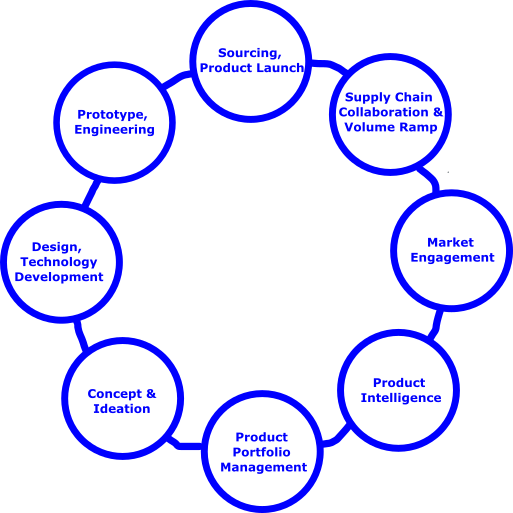
Consumer goods, industrial products or pharmaceutical drugs – they all follow a lifecycle of creation, production, consumption and replacement by better products. The value creation at every stage of the lifecycle is vital to the evolution of not just the businesses, but also our society and the planet. All engineering disciplines focus on this value creation and generally are manifested in velocity, utility and cost associated with the stage
Monetization of the value creation has traditionally been in the form of ownership transfer or throwing it over the wall. When you buy a smartphone, you pay the full price of the phone even if you use only 20% of its designed utility and eventually replace it with the new shiny toy. It has been simpler, though not most efficient, for businesses to sell you the utility through complete transfer of ownership of the product.
If there was a system of engagement, that runs seamlessly from creation through consumption, it should be possible to optimize velocity, cost and utility on a continual basis. One of the easiest way to visualize this is in the way streaming video services work today – both content and presentation are continually evolving and being delivered for one subscription fee. Development of such streaming platforms and operations are interwoven in modern software lifecycle such as DevOps.
Think of Digital thread and twin to be the DevOps equivalent for physical products. I believe Digital thread and twin, will help bridge the gap between businesses and consumers and create a system of continuous engagement where in product failures are predicted and corrective measures deployed before failure occurs , usage behavior guide the product design changes or introduction of new features and product just becomes a vehicle of delivery of a certain utility. Utility that is guaranteed and is the basis of pricing, as opposed to mindlessly designing, launching and selling new products. Provisioning the utility steadily, reliably and with progressive maturity, is key to subscription pricing model
What is Digital thread and twin, and how can it enable subscription pricing model for physical products? In order to answer this and other related questions, lets first examine various functions that a well designed Digital thread and twin framework entails. Following schematic, is a highly abstracted view of what I believe are essential elements of Digital thread and twin framework.

Product Portfolio Management: Based on market opportunities and trends, product intelligence, further development of existing products or entirely new products is planned at the enterprise or business level.
Concept and Ideation: Product intelligence is further broken down into aesthetic, functional and configuration related requirements, solution options are ideated for every requirement and potential options are further analyzed using conceptual models.
Design, Technology Development: Different aspects of the new product or changes in existing products, are designed by relevant discipline or specialization. Some of the requirements might necessitate new technology development and integration at this stage
Prototype, Engineering: Prototypes supporting the new design are created and material, performance, production, safety and regulatory aspects are analyzed and optimized. A final product definition (or Engineering Bill of Material) is arrived at, from geometry, performance, production and maintenance perspective
Sourcing, Product Launch: Make/Buy decisions for various components in the engineering bill of material and related supply chain decisions are taken at this stage. Once the fulfillment capacity is ascertained, product is launched in the target markets
Supply Chain Collaboration and Volume Ramp: Based on projected and firm demand, supply chain is activated and fulfillment engines are ramped for projected/actual demand on a continual basis
Market Engagement: Once the product reaches in the hands of the end user, user experience is collected and performance adjusted as per their requirements. A digital equivalent (twin) of the product is often used as a vehicle of continuous and ongoing engagement between the producer and consumer
Product Intelligence: Product capabilities and limits for different usage conditions are collated and fed back into the product development/engineering for a closed loop cadence to product innovation
Digital thread and twin framework is the set of process, people, data and IT tools which binds the different stages between product conception and rebirth. Before the formalization of Internet of things (IOT), market engagement and product intelligence functions were not as streamlined as to have a seamless flow of information required for closed loop cadence to product innovation
Digital thread and twin framework, however, is often deployed for facilitating the traditional business models of creating and transferring ownership of the products to the end user. I believe that the framework, can be and should be effectively deployed for a utility based consumption model owing to the following
a) Metering the utility – The utility that a user is deriving from the product can be assessed in real time and metered using digital thread and twin
b) Improving the utility – Key to subscription economy is that the focus is often on utility and not the product. Closed loop engineering can facilitate continuous improvement of utility – and can be delivered either through product replacement or through remotely upgrading the software defined features in the physical product
c) Sustainability – Since the focus is on utility, manufacturers will be incented to established a circular economy
d) Establishment of ecosystem – In order to provision the utility in efficient manner, ecosystem integration (such as which digital assistant should be used) will be manufacturers responsibility. Users will not have to deal with myriad of technology options and configurations to derive maximum utility from the product
In conclusion, I strongly believe that we all need a utility based consumption model, such as subscription based pricing and with the advent of digital thread and twin technologies, it is now possible for physical products to be offered in subscription pricing model. Digital thread and twin should not just be seen as a more profitable way to bring products to the market, but to even completely change the way products are developed and consumed
Let me know your thoughts!